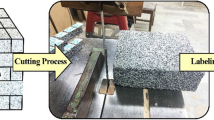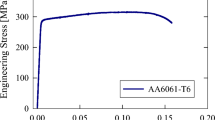Abstract
Metal foams are attracting interest in both aerospace and automotive industries due to their intriguing properties such as high stiffness coupled with low specific weight, good absorbing energy capabilities and flame resistance. To date, many researchers are trying to develop innovative solutions for the improvement of the mechanical properties of metal foams keeping the light-weight condition, with the scope to extend their potential application field. In this scenario, an advanced solution was here proposed; in particular, an innovative manufacturing process was presented for the production of steel grid–reinforced closed-cell aluminium foam cylinders in one single step by using the powder compact melting technique. The bending properties of plain, as well as reinforced, foam systems were experimentally tested and extensively discussed. An original finite element model was developed and validated for the analysis of the bending behaviour and the synergistic action of each component constituting the hybrid system, with a special focus on the failure mechanisms occurring under specified load conditions. The outcomes showed an increase of the mechanical properties of the reinforced systems due to the action of the light-weight mesh grid reinforcement that delays the failure of the structure. The solution proposed shows promises of being a useful method to expand the industrial applications of metal foams.












Similar content being viewed by others
References
Viscusi A, Ammendola P, Astarita A, Raganati F, Scherillo F, Squillace A, Chirone R, Carrino L (2016) Aluminum foam made via a new method based on cold gas dynamic sprayed powders mixed through sound assisted fluidization technique. J Mater Process Technol 231:265–276. https://doi.org/10.1016/j.jmatprotec.2015.12.030
Rubino F, Ammendola P, Astarita A, Raganati F, Squillace A, Viscusi A, Chirone R, Carrino L (2015) An innovative method to produce metal foam using cold gas dynamic spray process assisted by fluidized bed mixing of precursors. Key Eng Mater 651–653:913–918. https://doi.org/10.4028/www.scientific.net/KEM.651-653.913
Ashby MF (2000) Metal foams : a design guide. Butterworth-Heinemann
Deshpande VS, Fleck NA (2000) High strain rate compressive behaviour of aluminium alloy foams. Int J Impact Eng 24:277–298. https://doi.org/10.1016/S0734-743X(99)00153-0
Banhart J (2005) Aluminium foams for lighter vehicles. Int J Veh Des 37:114–125. https://doi.org/10.1504/IJVD.2005.006640
Idris MI, Vodenitcharova T, Hoffman M (2009) Mechanical behaviour and energy absorption of closed-cell aluminium foam panels in uniaxial compression. Mater Sci Eng A 517:37–45. https://doi.org/10.1016/j.msea.2009.03.067
Rajak DK, Kumaraswamidhas LA, Das S (2014) An energy absorption behaviour of foam filled structures. Procedia Mater Sci 5:164–172. https://doi.org/10.1016/j.mspro.2014.07.254
Peroni L, Avalle M, Peroni M (2008) The mechanical behaviour of aluminium foam structures in different loading conditions. Int J Impact Eng 35:644–658. https://doi.org/10.1016/j.ijimpeng.2007.02.007
Hashim UR, Jumahat A, Ismail MH, Razali RNM (2014) Fabrication and characterisation of carbon fibre reinforced polymer rods with aluminium foam core. Mater Res Innov 18:S6–204-S6-208. https://doi.org/10.1179/1432891714Z.000000000957
Styles M, Compston P, Kalyanasundaram S (2007) The effect of core thickness on the flexural behaviour of aluminium foam sandwich structures. Compos Struct 80:532–538. https://doi.org/10.1016/j.compstruct.2006.07.002
Carrino L, Durante M, Franchitti S, Sorrentino L (2012) Mechanical performance analysis of hybrid metal-foam/composite samples. Int J Adv Manuf Technol 60:181–190. https://doi.org/10.1007/s00170-011-3603-0
Formisano A, Durante M (2017) Mechanical characterization and fem modeling of hybrid metal foam/bio-composite samples. Int Rev Model Simulations 10:320–327. https://doi.org/10.15866/iremos.v10i5.13687
Rajak DK, Kumaraswamidhas LA, Das S (2016) Investigation and characterisation of aluminium alloy foams with TiH 2 as a foaming agent. Mater Sci Technol 32:1338–1345. https://doi.org/10.1080/02670836.2015.1123846
Wang X-Z, Wu L-Z, Wang S-X (2009) Tensile and shear properties of aluminium foam. Mater Technol 24:161–165. https://doi.org/10.1179/106678509X12475884746705
Giancane S, De Giorgi M, Nobile R, Dattoma V (2014) Shear characterization of aluminum foams by digital image correlation. Mech Adv Mater Struct 21:553–558. https://doi.org/10.1080/15376494.2012.699598
Raj RE, Daniel BSS (2008) Prediction of compressive properties of closed-cell aluminum foam using artificial neural network. Comput Mater Sci 43:767–773. https://doi.org/10.1016/j.commatsci.2008.01.041
Zhou J, Soboyejo WO (2004) Mechanics modeling of the compressive stiffness and strength of open-celled aluminum foams. Mater Manuf Process 19:863–882. https://doi.org/10.1081/AMP-200030584
Zhang X, Wu Y, Tang L, Liu Z, Jiang Z, Liu Y, Xi H (2018) Modeling and computing parameters of three-dimensional Voronoi models in nonlinear finite element simulation of closed-cell metallic foams. Mech Adv Mater Struct 25:1265–1275. https://doi.org/10.1080/15376494.2016.1190426
Gagliardi F, Umbrello D, Filice L et al (2009) Simulation of aluminum foam behavior in compression test. Arab J Sci Eng 34:129–137 https://ajse.kfupm.edu.sa/articles/341c_p.13.pdf
Czekanski A, Elbestawi MA, Meguid SA (2005) On the FE modeling of closed-cell aluminum foam. Int J Mech Mater Des 2:23–34. https://doi.org/10.1007/s10999-005-0518-7
Formisano A (2017) Shell-based numerical modelling and experimental validation of closed-cell aluminum foams. Int Rev Model Simulations 10:55–61. https://doi.org/10.15866/iremos.v10i1.11820
Styles M, Compston P, Kalyanasundaram S (2008) Finite element modelling of core thickness effects in aluminium foam/composite sandwich structures under flexural loading. Compos Struct 86:227–232. https://doi.org/10.1016/j.compstruct.2008.03.024
Liu C, Zhang YX, Ye L (2017) High velocity impact responses of sandwich panels with metal fibre laminate skins and aluminium foam core. Int J Impact Eng 100:139–153. https://doi.org/10.1016/j.ijimpeng.2016.09.004
Rizov V, Shipsha A, Zenkert D (2005) Indentation study of foam core sandwich composite panels. Compos Struct 69:95–102. https://doi.org/10.1016/j.compstruct.2004.05.013
Mohan K, Yip T-H, Sridhar I, Seow HP (2007) Effect of face sheet material on the indentation response of metallic foams. J Mater Sci 42:3714–3723. https://doi.org/10.1007/s10853-006-0373-4
Mohan K, Yip TH, Idapalapati S, Chen Z (2011) Impact response of aluminum foam core sandwich structures. Mater Sci Eng A 529:94–101. https://doi.org/10.1016/j.msea.2011.08.066
Vaidya UK, Pillay S, Bartus S, Ulven CA, Grow DT, Mathew B (2006) Impact and post-impact vibration response of protective metal foam composite sandwich plates. Mater Sci Eng A 428:59–66. https://doi.org/10.1016/j.msea.2006.04.114
Formisano A, Carrino L, De Fazio D et al (2018) Enhanced aluminium foam based cylindrical sandwiches: bending behaviour and numerical modeling. Int Rev Model Simulations 11:198–205. https://doi.org/10.15866/iremos.v11i4.15631
An Y, Yang S, Zhao E, Wang Z (2017) Characterization of metal grid-structure reinforced aluminum foam under quasi-static bending loads. Compos Struct 178:288–296. https://doi.org/10.1016/j.compstruct.2017.07.031
Formisano A, Barone A, Carrino L, et al (2018) Improvement of the mechanical properties of reinforced aluminum foam samples. In: AIP conference proceedings. P 100007
Banhart J (2001) Manufacture, characterisation and application of cellular metals and metal foams. Prog Mater Sci 46:559–632. https://doi.org/10.1016/S0079-6425(00)00002-5
https://www.matweb.com/overview-of-materials-for-T-300-Series-Stainless-Steel. Accessed 13 Dec 2018
McCullough KYG, Fleck NA, Ashby MF (1999) Uniaxial stress–strain behaviour of aluminium alloy foams. Acta Mater 47:2323–2330. https://doi.org/10.1016/S1359-6454(99)00128-7
Dassault Systèmes Simulia Corp (2010) ABAQUS/Explicit 6.10 user manual. Providence
Deshpande VS, Fleck NA (2000) Isotropic constitutive models for metallic foams. J Mech Phys Solids 48:1253–1283. https://doi.org/10.1016/S0022-5096(99)00082-4
Boyce AM, Deshpande VS, Fleck NA (2017) On the indentation resistance of a pc layer on PVC foam substrate. Adv Eng Mater 19:1700075. https://doi.org/10.1002/adem.201700075
Sridhar I, Fleck NA (2005) The multiaxial yield behaviour of an aluminium alloy foam. J Mater Sci 40:4005–4008. https://doi.org/10.1007/s10853-005-1916-9
Mccullough KYG, Fleck NA, Ashby MF (1999) Toughness of aluminium alloy foams. Acta Mater 47:2331–2343. https://doi.org/10.1016/S1359-6454(99)00125-1
Mills WJ (1997) Fracture toughness of type 304 and 316 stainless steels and their welds. Int Mater Rev 42:45–82. https://doi.org/10.1179/imr.1997.42.2.45
Picker CTI (1983) The fracture toughness of type 316 steel and weld metal. Spec Meet Mech Prop Struct Mater Incl Environ Eff 19:915–937
Author information
Authors and Affiliations
Corresponding author
Additional information
Publisher’s note
Springer Nature remains neutral with regard to jurisdictional claims in published maps and institutional affiliations.
Rights and permissions
About this article
Cite this article
Viscusi, A., Carrino, L., Durante, M. et al. On the bending behaviour and the failure mechanisms of grid-reinforced aluminium foam cylinders by using an experimental/numerical approach. Int J Adv Manuf Technol 106, 1683–1693 (2020). https://doi.org/10.1007/s00170-019-04414-6
Received:
Accepted:
Published:
Issue Date:
DOI: https://doi.org/10.1007/s00170-019-04414-6




